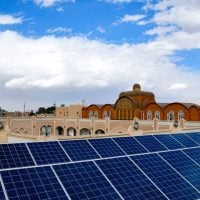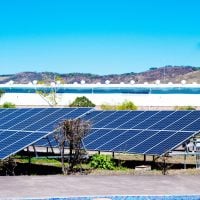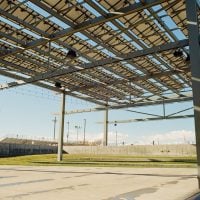As the world grapples with the escalating impacts of climate change, the need for climate-resilient energy solutions has never been more pressing. These solutions encompass a range of technologies and strategies designed to ensure that energy systems can withstand and adapt to the changing climate while also reducing greenhouse gas emissions. From renewable energy sources like solar and wind to innovative energy storage systems and smart grid technologies, climate-resilient energy solutions are essential for building a sustainable future.
They not only help mitigate the effects of climate change but also enhance energy security, promote economic development, and improve public health. The transition to climate-resilient energy systems is not merely a technical challenge; it is also a social and economic imperative. Communities around the globe are already experiencing the adverse effects of climate change, including extreme weather events, rising sea levels, and shifting agricultural patterns.
By investing in energy solutions that are resilient to these changes, we can empower communities to thrive in the face of adversity. This article will explore the critical role of funding in advancing climate-resilient energy solutions, highlight key donors in this space, and examine the tangible impacts these initiatives have on communities worldwide. Are You Working on Solar Innovation or Clean Energy Access? Join us to receive updates.
The Importance of Funding for Climate-Resilient Energy Solutions
Funding is the lifeblood of any initiative aimed at fostering climate-resilient energy solutions. Without adequate financial resources, even the most innovative ideas can remain dormant, unable to transition from concept to reality. The urgency of climate change necessitates a significant increase in investment across various sectors, including renewable energy, energy efficiency, and infrastructure development.
Governments, private investors, and philanthropic organizations must collaborate to mobilize the necessary capital to support these initiatives. Moreover, funding is crucial for research and development in the climate-resilient energy sector. Innovative technologies often require substantial upfront investment before they can be deployed at scale.
For instance, advancements in battery storage technology are essential for integrating renewable energy sources into existing grids. However, these technologies need rigorous testing and validation before they can be widely adopted. By providing funding for research and pilot projects, donors can help accelerate the development of solutions that will ultimately benefit communities and contribute to global climate goals.
Overview of Top Donors in the Climate-Resilient Energy Sector
In the realm of climate-resilient energy solutions, several key donors have emerged as leaders in funding initiatives that drive innovation and implementation. Multilateral development banks such as the World Bank and regional entities like the Asian Development Bank play a pivotal role in financing large-scale projects that enhance energy resilience in developing countries. These institutions often provide low-interest loans and grants to support infrastructure development and capacity-building efforts.
In addition to multilateral organizations, philanthropic foundations such as the Rockefeller Foundation and the Bill & Melinda Gates Foundation have made significant contributions to climate-resilient energy initiatives. These foundations often focus on innovative approaches that leverage technology and community engagement to create sustainable energy solutions. Their funding not only supports project implementation but also fosters collaboration among stakeholders, ensuring that diverse perspectives are included in the decision-making process.
The Impact of Climate-Resilient Energy Solutions on Communities
The implementation of climate-resilient energy solutions has far-reaching impacts on communities, particularly those that are vulnerable to the effects of climate change. By investing in renewable energy sources such as solar and wind, communities can reduce their dependence on fossil fuels, leading to lower greenhouse gas emissions and improved air quality. This transition not only benefits the environment but also enhances public health by reducing respiratory illnesses associated with pollution.
Furthermore, climate-resilient energy solutions can stimulate local economies by creating jobs and fostering entrepreneurship. For example, the installation of solar panels requires skilled labor for design, installation, and maintenance. This demand for skilled workers can lead to job creation in local communities, providing economic opportunities for residents.
Additionally, by investing in decentralized energy systems, communities can gain greater control over their energy supply, reducing vulnerability to external shocks such as price fluctuations or supply disruptions.
How Top Donors are Supporting Climate-Resilient Energy Solutions
Top donors are increasingly recognizing the importance of supporting climate-resilient energy solutions through targeted funding strategies. Many donors are prioritizing investments in projects that demonstrate a clear alignment with climate goals while also addressing social equity issues. For instance, some foundations are focusing on initiatives that provide access to clean energy for marginalized communities, ensuring that the benefits of renewable energy are equitably distributed.
Moreover, donors are leveraging their funding to catalyze additional investments from private sector actors. By providing initial capital or guarantees, donors can reduce perceived risks associated with investing in climate-resilient projects. This approach not only mobilizes additional resources but also encourages innovation as private companies seek to develop new technologies and business models that align with sustainability goals.
Case Studies of Successful Climate-Resilient Energy Projects Funded by Top Donors
Several successful case studies illustrate the transformative impact of donor-funded climate-resilient energy projects around the world. One notable example is the Solar Home Systems project in Bangladesh, which has been supported by various international donors including the Global Environment Facility (GEF) and the World Bank. This initiative has provided solar power to millions of households in rural areas, significantly improving access to electricity while reducing reliance on kerosene lamps.
The project has not only enhanced living standards but has also empowered women by enabling them to engage in income-generating activities after dark. Another compelling case is the African Development Bank’s support for renewable energy projects across Africa. Through its New Deal on Energy for Africa initiative, the bank has mobilized funding for solar, wind, and hydroelectric projects that aim to provide reliable electricity to underserved populations.
These projects have demonstrated significant social and economic benefits, including job creation and improved educational opportunities as schools gain access to electricity.
Challenges and Opportunities in Funding Climate-Resilient Energy Solutions
Despite the progress made in funding climate-resilient energy solutions, several challenges persist that hinder further advancements. One major obstacle is the lack of consistent funding mechanisms that can support long-term projects. Many donors tend to focus on short-term initiatives or pilot programs, which can limit the scalability of successful solutions.
To address this challenge, it is essential for donors to adopt a more strategic approach that prioritizes sustained investment over time. Additionally, there is often a disconnect between funding availability and local needs. In many cases, communities may lack the capacity to effectively engage with potential funders or may not be aware of available resources.
This gap highlights the importance of building local capacity through training and education initiatives that empower communities to advocate for their own needs and access funding opportunities.
The Role of Public-Private Partnerships in Funding Climate-Resilient Energy Solutions
Public-private partnerships (PPPs) have emerged as a powerful mechanism for financing climate-resilient energy solutions. By bringing together government entities, private companies, and civil society organizations, PPPs can leverage diverse resources and expertise to implement innovative projects. These collaborations often result in more efficient use of funds and greater accountability in project execution.
For instance, a successful PPP model can be seen in the development of off-grid solar solutions in rural areas of India. In this case, government incentives have attracted private investment from companies specializing in renewable energy technologies. By working together, these stakeholders have been able to deploy solar microgrids that provide reliable electricity to remote communities while also creating local jobs in installation and maintenance.
The Future of Climate-Resilient Energy Solutions and the Role of Top Donors
Looking ahead, the future of climate-resilient energy solutions will depend heavily on continued support from top donors who recognize the urgency of addressing climate change. As global temperatures rise and extreme weather events become more frequent, the demand for innovative energy solutions will only increase. Donors must remain agile and responsive to emerging challenges while also fostering collaboration among stakeholders across sectors.
Moreover, as technology continues to evolve rapidly, there will be new opportunities for donors to invest in cutting-edge solutions that enhance resilience. For example, advancements in artificial intelligence and data analytics can improve energy management systems, optimizing resource allocation and reducing waste. By staying informed about technological trends and investing strategically, donors can maximize their impact on climate-resilient energy initiatives.
Recommendations for Maximizing the Impact of Donor Funding on Climate-Resilient Energy Solutions
To maximize the impact of donor funding on climate-resilient energy solutions, several key recommendations should be considered. First and foremost, donors should prioritize long-term investments that support scalable projects with proven track records of success. This approach will ensure that resources are allocated effectively and that successful initiatives can be expanded to reach more communities.
Additionally, fostering collaboration among stakeholders is essential for creating synergies that enhance project outcomes. Donors should encourage partnerships between governments, private sector actors, and civil society organizations to leverage diverse expertise and resources. By facilitating dialogue among these groups, donors can help identify shared goals and develop integrated strategies that address both environmental sustainability and social equity.
The Continued Need for Funding Climate-Resilient Energy Solutions
In conclusion, the need for funding climate-resilient energy solutions is more critical than ever as we confront the realities of climate change. Through strategic investments from top donors—ranging from multilateral development banks to philanthropic foundations—we can accelerate the transition toward sustainable energy systems that benefit communities worldwide. By prioritizing long-term funding commitments, fostering collaboration among stakeholders, and embracing innovative technologies, we can create a resilient future where all communities have access to clean and reliable energy sources.
The journey toward a sustainable world requires collective action; thus, continued support for climate-resilient energy solutions is essential for safeguarding our planet for generations to come.
In the realm of climate-resilient energy solutions, top donors are increasingly focusing on sustainable practices that can withstand the challenges posed by climate change. A related initiative is the CFPS General Practice Sustainability and Viability Initiative in Australia, which aims to support sustainable practices within the healthcare sector. This initiative highlights the growing trend of integrating sustainability into various sectors, ensuring that essential services remain resilient and viable in the face of environmental challenges. By aligning with such initiatives, donors can amplify their impact on promoting sustainable and climate-resilient solutions across different industries.









































